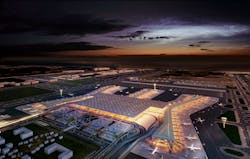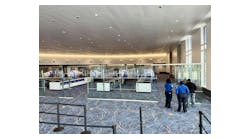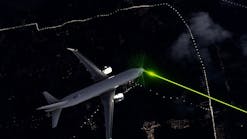Each day, airports navigate numerous processes and systems to maintain a delicate balance that enables flights to land and depart so passengers can safely and efficiently move between their destinations—and hopefully enjoy a pleasant experience along the way. Behind this balance is an increasingly complex web of integrated systems working hard to ensure passenger movement syncs with plane traffic, and to keep flights on schedule. It’s a process that requires careful integration, coordination and nimbleness, and spans landside, airside and terminal operations.
If statistics are any indication, airports will continue to have their work cut out for them. According to the International Air Transport Association (IATA), last year’s global passenger traffic was up 6.3 percent over 2015—a figure the trade association says is well ahead of the 10-year average annual growth rate of 5.5 percent. As these figures increase, with more people traveling between all corners of the world, airports must scale their supporting technologies to match and ensure continued safe and efficient travel. That’s where smart, integrated technology can have a real impact, particularly where travel starts and ends: at the gate and on the runway.
Envisioning Integrated Operations
Case in point: The Istanbul New Airport, which is set to open in October in Turkey’s largest city. Often referred to as the gateway between the East and the West, Istanbul is an increasingly critical aviation linchpin in global travel. The construction of the new airport is evidence of that, as upon completion, it will accommodate more than 150 million passengers annually and serve more than 350 destinations. In order to ensure the Istanbul New Airport can adequately accommodate the anticipated high volume of airline traffic, construction and design elements are focused on driving efficiencies at gates and on the runways—critical focal points in overall airport operations.
Specifically, the project includes the development of three independent runways and a main terminal with 114 advanced-visual docking guidance systems (A-VDGS) in phase 1. The smart technology that Honeywell is providing focuses on maximizing the precision of aircraft movements to and from gates while providing continuous gate monitoring so that pilots can safely dock planes faster, and with better accuracy. With a high-dynamic range sensor, high-capacity image processing unit and image-processing techniques at its core, the system detects incoming aircraft and converts the processed data into precise guidance information. A pilot display unit (PDU) then displays the information for safe docking.
A-VDGS can also integrate with other airport IT systems, including monitoring and control systems, as well as advanced surface movement guidance and control systems, and other technologies that enable collaborative decision making. This deep integration can provide more precise and up-to-date insights on flight logistics so aviation personnel can address issues quicker, such as possible gate conflicts.
When implemented, the smart docking system will help Istanbul New Airport streamline operations by managing airplane turnaround and promoting safer, more reliable docking under all weather conditions for all aircraft types. The airport will also be able to more easily scale to accommodate future growth—all while maximizing passenger safety at what’s expected to be one of the world’s busiest airports.
Blueprint for Soaring Success
In the constant quest for efficiencies, it goes without saying that gate and runway operations are among the key contributors to an airport’s success. As the Istanbul New Airport demonstrates, how and where airports apply smart technologies can help lay the groundwork for optimal operations. When adopted, an integrated technology approach can provide the following benefits:
- Repeated reliability – With integrated technologies as a backbone, airports can automate processes like gate positioning and docking—traditionally manual tasks—and effectively eliminate degrees of uncertainty that can affect safety and efficiency, thanks to heightened awareness of lateral and longitudinal guidance. Turning once-manual processes into automated processes, integrated tasks can also help overcome challenges brought by severe weather and other issues that can threaten an airport’s ability to run smoothly.
- Universally understandable – Integrated technologies also introduce a universal language: the language of automation. When applied to the docking process, for example, integration can replace traditional manual methods that largely rely on hand signals and increase the chance for errors. Not all hand signals are universally understood, and crew members can also forget them, or misinterpret them—and sometimes take a significant amount of time to learn them. With integrated technologies, pilots can receive information like guidance data for safe docking and maneuver the tarmac in a safe and efficient manner.
- Better insight and control for enhanced efficiencies – Airports are increasingly comprised of more and more data points, rife with information to improve operations—if the right technology is in place. Leveraging the details stored in a central airport operational database, automated technologies can offer airports enhanced oversight into daily operations, enabling them to keep tabs on aircraft landing and docking turn-around times for maximum efficiency. Beyond this, detection technology can quickly alert workers of unexpected events during the landing and docking process, further contributing to overall operational awareness.
- Reduced installation and operating costs – An airport’s essential activities and technologies can quickly rack up costs, including installation and operational costs. When applied correctly, however, integrated technologies can drive efficiencies to ultimately save money. For example, smart docking systems, backed by image processing, can help reduce the number of required docking systems. And, because of its passive sensor technology, such systems offer the additional benefit of helping drive down operating costs. Integration can also provide the real-time insight to help airports more quickly and easily pinpoint issues like equipment failures and facilitate faster response and repair.
- Improved safety – Integrated technologies can contribute significant safety improvements by driving enhanced automation and awareness to help reduce the chance of human error during the times when aircrafts are docking at gates. Tight integration between all gate systems can enable automated operations to check if the passenger boarding bridge is in a parked or safe position to receive the intended aircraft type and provide seamless guidance to help pilots safely navigate the aircraft into the gate. Integration can also promote safe operations by helping prevent injury to aircraft marshalling staff during events like thunderstorms
Raghu Seelamonthula is a Director – Products & Solutions for Airport Systems at Honeywell Airports Business, part of Honeywell International Inc. He received a BS in Computer Science & Engineering degree from Osmania University and MBA degree from Sri Satya Sai University. He has been in the industry for 20 years (the past ten years with Honeywell) and is a global advocate and subject matter expert for airport integration technology and the benefits it can provide to airports, airlines, air navigation service providers, communities, and the flying public. He is currently involved in various airport systems projects across Asia Pacific, Middle East, and Europe and actively involved in Honeywell contributions to SESAR-JU programs.




